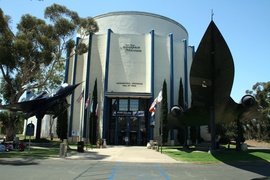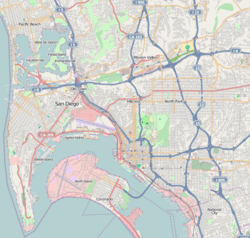Ford Building (San Diego) facts for kids
|
Ford Building
|
|

The Ford Building
|
|
| Location | Balboa Park, Palisades Area, San Diego, California |
|---|---|
| Area | 5 acres (2.0 ha) |
| Built | 1935 |
| Architect | Walter Dorwin Teague |
| Architectural style | Moderne |
| NRHP reference No. | 73000433 |
Quick facts for kids Significant dates |
|
| Added to NRHP | April 26, 1973 |
The Ford Building is a cool building in Balboa Park in San Diego, California. It has a special design called Streamline Moderne, which looks very sleek and modern. Today, it's home to the San Diego Air & Space Museum.
This building was first built by the Ford Motor Company for a big fair called the California Pacific International Exposition. This fair happened in 1935 and 1936. Inside the museum, there's a large area called Ford's Hall. It's often used for fun events like weddings, dances, and parties.
Contents
Building Design and Construction
The Ford Building was designed by a famous American industrial designer named Walter Dorwin Teague. He made the building look like a giant V8 engine, which is a type of car engine.
The building is shaped like the number "8," with two circles of different sizes. In the middle of the larger circle, there's a big fountain. This fountain is shaped like the Ford V8 logo. Even the lights in the courtyard, called the "Pavilion of Flight," look like engine valves!
Along the inside wall of the outer ring, there's a long painting called a mural. This mural shows the history of transportation. It starts from the time of hunter-gatherers and goes all the way up to 1935. The last part of the mural was left empty. The artist wanted to show his ideas for the future of transportation after 1935. You can still see this part today.
Ford first wanted a very tall building, about 200 feet high. But the building was close to the flight path for planes arriving at San Diego International Airport. So, the height was lowered to 90 feet. The size of the building was also made smaller. It went from a planned 113,000 square feet to 60,000 square feet.
The building was originally going to be built near the Spreckels Organ Pavilion. However, it was later decided to build it in the Palisades area of the park. It took only 11 months to finish building it. The main exhibit hall was made of cement plaster with a strong steel frame.
History of the Ford Building
The Ford Motor Company was the main company showing off its products at the exposition. Ford spent a lot of money, about $2 million, on the building. It was 45,000 square feet and 296 feet wide. Ford used it to show off their cars and other ways people travel.
During the exposition, Ford workers actually put cars together along the outer rings of the building. The courtyard area was used to display the newest car models. The newly built cars were then driven out through large doors on the west side. There was also a test track set up behind the building. Visitors could take one of the new cars for a test drive there.
By the end of the fair, 2.5 million people had visited the Ford Building. Ford gave the building to the city of San Diego when the exposition ended in November 1935. The city decided to continue the fair into 1936. They renamed the building "The Palace of Transportation." It was used to show exhibits about different ways to travel. After the 1936 fair ended, the building was closed. It stayed closed to the public until 1980. That's when the San Diego Air & Space Museum opened there.
While the building was empty, the United States National Guard used it for a short time. They stored military equipment like anti-aircraft artillery and trucks there. During World War II, Balboa Park was used by the U.S. Navy. The Ford Building was used to train mechanics in aircraft repair and welding from 1941 to 1946. A company called Convair thought about using the building to build B-24 Liberator planes. But they realized the building was too small for the plane's very long wings.
From the late 1940s to the 1960s, the building was used for storage. It held items for the Starlight Civic Opera and San Diego's Park and Recreation department. By this time, the building was in bad shape. In 1960, a group suggested that it should be torn down.
In the late 1960s, a group of Chicano artists called Los Toltecas en Azatlán used the building as a temporary art studio. In 1973, several groups in San Diego worked hard to save the building. They got it listed on the National Register of Historic Places, which stopped it from being destroyed.
Los Toltecas en Aztlán Art Studio
In 1968, the San Diego Parks and Recreation Department allowed a Chicano artist named Salvador Roberto Torres to use the empty Ford building. He could use it as a studio for six months. Torres then invited other Chicano artists to join him in the building. Together, they formed the group Los Toltecas en Azatlán.
In 1970, Los Toltecas en Azatlán suggested creating El Centro Cultural de la Raza. They wanted to keep the Ford Building as a place for cultural art. The city of San Diego said no to their idea. But Los Toltecas en Azatlán decided to stay and use the building anyway. They stayed until 1971. Then, the city agreed to give them another space in Balboa Park for their cultural center.
Home of the Air and Space Museum
When the city was deciding to add the Ford Building to the National Register, they had another idea. The San Diego City Council suggested it could be the new home for the Air and Space Museum. The museum's old location had burned down in a fire in 1978.
So, the Ford Building was renovated to house the museum. This cost $8 million. The San Diego Air & Space Museum officially opened in the Ford Building on June 28, 1980.
See also
 In Spanish: Edificio Ford (San Diego) para niños
In Spanish: Edificio Ford (San Diego) para niños





